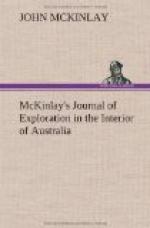Sunday, October 20.
At daylight about 90 to 100 natives of all sorts visited us; they were not so unruly as those of the morning before, having evidently had some communication with whites—using the word Yanaman for horse, as in Sydney, and one or two other words familiar to me. Plenty of fish, of sorts, in the lake, although not very deep. Cuddibaien bears 100 degrees. The natives here say that the whites have left above place and are now at Undaganie. I observed several portions of European clothing about their camps as on our course we passed them. At the camp we found twenty to thirty more natives, principally aged and children; and on the opposite side of the lake there was another encampment, in all numbering about 150 souls. The sandhills in our course were exceedingly high on the western side but pretty hard; but on the eastern side almost precipitous and soft drift sand; a dray or cart might get east, but I cannot fancy it possible it could return. An exceedingly hot day, wind north. On our way the natives informed us that the natives we had left in the morning had murdered the man said to be at the end of our day’s stage. On some of the ridges and on crossing a large flat creek I observed two new trees or shrubs (they are both) from one I obtained some seeds like beans, and rather a nice tree; the other, when large, at a distance looks like a shea-oak, having a very dark butt and long, drooping, dark-green, narrow leaves, and did not appear to have any seeds at present. Started at 7.17 till twenty-two minutes to 10, nine miles, on a bearing of from 100 to 105 degrees; at 8.18 sighted a large timbered creek, distant one mile, for about seven miles, 360 to 140 degrees. At twenty-two minutes to 10 observed a large dry salt lake bearing 341 degrees, north-west arm 330 degrees, north arm 355 degrees, distance to extreme point of north bank nine miles. Bullingani informed us that a large lake lay on a bearing of 110 degrees, some distance off, named Murri Murri Ando. At




